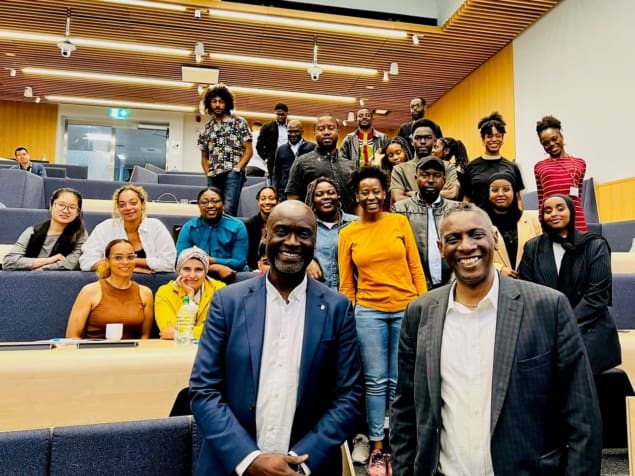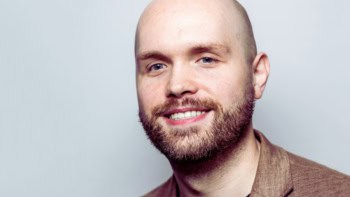This article is the fifth in a series of essays written by Black physicists and co-published with Physics Today as part of #BlackInPhysics week 2022, an event dedicated to celebrating Black physicists and their contributions to the scientific community, and to revealing a more complete picture of what a physicist looks like. This year’s theme is “joy in the diverse Black community”.

As a child, I used to like dot-to-dot drawings. I never really considered myself artistic, but I enjoyed the fact that if I followed the numbers and connected the dots, the “big picture” would ultimately be revealed. This was very rewarding to me. In many ways, it felt like a discovery.
In science, it’s often the big picture that we initially observe, and this usually leads to probing questions about its origins, form and nature, delving ever deeper until we deduce the fundamental building blocks that comprise the big picture. It’s almost like the reverse of a very sophisticated dot-to-dot drawing. At this fundamental level, the building blocks (or elementary particles) often lie within the quantum world, and it was quantum theory that propelled my journey into physics.
As an undergraduate studying chemistry, I was mesmerized by spectroscopy – a technique that uses light to probe, characterize and quantify different types of matter (solids, liquids or gases). I was struck by the fact that this technique could take “invisible” light (for example, ultraviolet or infrared light) and use it to probe the “invisible” air, accurately detecting unseen trace gas particles like carbon monoxide or sulphur dioxide. Through spectroscopy, these trace gases become “visible” and appear in the form of spectral absorption peaks at specific wavelengths, thus providing a unique spectral fingerprint for each gas. This information can then be used to determine which types of gas are present, and their abundance.
The more I asked, “How this could be?” the more I found myself being drawn towards fundamental physics. The idea of making the unseen visible has stayed with me ever since. It’s amazing to think that the principles of quantum mechanics underpin this powerful technique. Not only that, but quantum theory more generally gives rise to many other technologies such as lasers, the semiconductor, MRI, GPS, electron microscopy, cryptography and quantum computing just to name a few.
QDot technology
A more recent development in quantum mechanics is the rise of quantum dot (QDot) technology. A QDot is a semiconducting particle with optical and electronic properties that are governed by the rules of quantum mechanics due to their size of just a few nanometres – about 10,000 times smaller than the width of a human hair. These nanoparticles emit light of a specific wavelength when a blue LED shines on them. The wavelength emitted depends on the size of the nanoparticle and determines the colour observed.
Not surprisingly, QDot technology has found its way into flat-panel displays for modern television sets, due to the high colour saturation that can be achieved over a narrow spectral bandwidth. Furthermore, since QDots can be tuned to a determined size to release specific wavelengths, we can use them to achieve high colour rendering and overall better colour production. Each QDot TV typically contains billions of quantum dots that ultimately comprise the big picture.
Connecting the dots
As an early-career Black physicist and the son of Jamaican parents living in the UK, I very much felt like I was a quantum dot – a quantum black dot (QBD), if you will. In my research field, it was rare for someone who looked like me to be at the same seminar, conference or even in the same field. Against a backdrop of blue light, I had to find a way to radiate at different wavelengths, while knowing that the real powers of QBDs are harnessed when they’re connected and working collectively. In this endeavour, I was fortunate to discover and eventually meet many prominent African-American physicists, some while they visited the UK, others while I visited the US. I was also made aware of and eventually attended a conference for Black physicists in the US, as well as connecting with scientists from Africa and the Caribbean. These interactions helped strengthen my conviction that from a global perspective, there were plenty of QBDs just like me.
My thoughts soon turned to future generations in the UK. I wanted the situation to be different for them, so I engaged heavily with schools and set up several outreach initiatives for young people, trying to do what I could to change their landscape for the future. I also engaged with the handful of Black undergraduates in my department, encouraging them to assist with such endeavours. It was pleasing to know that they were, in the main, fully on board. Most stayed connected after graduating and, year after year, the group grew in number until it reached a critical mass. A unique identity was emerging for ambitious young Black people with a passion for physics and for positive change within their community.

Pursuing joy in an alien world
This effort culminated in the formation of The Blackett Lab Family – the UK’s first national network of Black physicists – in 2020. The group now has visibility and has become a voice for Black physicists in the UK. Furthermore, it provides an accessible means of support to anyone pursuing physics or related fields from high school through to professorial level. More recently, the Blackett Lab Family has received funding to connect African-American physicists with UK-based Black physicists through a speaker series in the UK as well as sending a UK delegation to conferences in the US, further strengthening the global community of Black physicists. Such exciting programmes are only possible because the QBDs across the UK are connected and can act collectively.
When I reflect on my career so far, it really has been a case of connecting QBDs in various ways over time and space. Often, QBD connections bring a deeper joy and enrichment to the overall discipline, and further enhance that vital sense of belonging. In many ways, though I am still a QBD, I now know that I’m part of a much larger national and global community of physicists from across the pan-African diaspora. The more we continue to connect, represent and inspire, the more we will reshape, sharpen and enrich the image of the big picture showing who physicists are and what we do.



